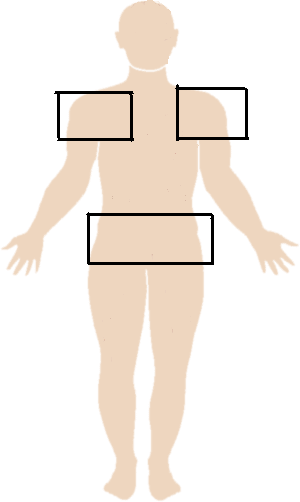Polymyalgia rheumatica overview
Editor-In-Chief: C. Michael Gibson, M.S., M.D. [1]; Associate Editor-In-Chief: Cafer Zorkun, M.D., Ph.D. [2] Ujjwal Rastogi, MBBS [3]
|
Polymyalgia Rheumatica Microchapters |
|
Diagnosis |
|---|
|
Treatment |
|
Case Studies |
|
Polymyalgia rheumatica overview On the Web |
|
American Roentgen Ray Society Images of Polymyalgia rheumatica overview |
|
Risk calculators and risk factors for Polymyalgia rheumatica overview |
Overview

Polymyalgia rheumatica (PMR) is a chronic inflammatory disease that involves the articular and periarticular parts of the cervical region, shoulder girdle and pelvic girdle. PMR affects subjects over the age of 50 years and it is characterized by pain and stiffness in the neck, shoulders, upper arms, hip and thighs. Although myalgia is one of the symptoms of PMR, there is no inflammation of the muscles; instead, PMR is a disease of the joint that causes synovitis. The diagnosis of PMR relies on the clinical findings and laboratory evidence of systemic inflammation. PMR is associated with giant cell arteritis. The cause of PMR is unknown but it has been suggested that both genetic and environmental factors are implicated.[1] The mainstay of treatment of PMR is steroid therapy.[1]
Historical Perspective
Polymyalgia rheumatica was first described in 1888 by Bruce William as "senile rheumatic gout".[2] The disease was referred to as "polymyalgia rheumatica" by Stuart Barber in 1957 in his article entitled "mylagic syndrome with constitutional effects; polymyalgia rheumatica".[3]
Pathophysiology
Polymyalgia rheumatica (PMR) is a chronic inflammatory disease of the articular and periarticular structures of the cervical region, shoulder girdle and hip girdle. The underlying pathophysiology of PMR remains unknown.[1] It has been hypothesized that genetic and environmental factors are implicated, particularly due to the seasonal and geographical differences in the prevalence of this disease.[4][5][6] It has also been hypothesized that PMR is associated with infections such as parainfluenza virus type 1,[7] mycoplasma pneumoniae, chlamydia pneumoniae, and parvovirus B19.[8] In addition, histological examinations of synovial biopsies of affected individuals reveal mild synovitis with predominance of CD4 T cells and macrophages.[9] Although myalgia is a symptom of PMR, there is no inflammation of the muscles.
Differential Diagnosis
Polymyalgia rheumatica (PMR) must be differentiated from other conditions such as late onset rheumatoid arthritis, polymyositis, dermatomyositis, fibromyalgia, and remitting seronegative symmetrical synovitis with pitting edema.
Epidemiology and Demographics
Polymyalgia rheumatica (PMR) affects mostly subjects who are more than 50 years of age.[10] The prevalence of PMR is highest among subjects from Scandanavian countries and those from northern European origin.[11]
Risk Factors
Age, female sex, Scandanavian and northern Europe origin are risk factors for polymyalgia rheumatica. Smoking, sun exposure, infections, nulliparity have also been considered risk factors.[12]
Natural History, Complications and Prognosis
Diagnosis
Diagnostic Criteria
History and Symptoms
Laboratory Findings
MRI
Ultrasound
Medical Therapy
Other Diagnostic Studies
References
- ↑ 1.0 1.1 1.2 Kermani TA, Warrington KJ (2013). "Polymyalgia rheumatica". Lancet. 381 (9860): 63–72. doi:10.1016/S0140-6736(12)60680-1. PMID 23051717.
- ↑ Bruce W (1888). "Senile Rheumatic Gout". Br Med J. 2 (1450): 811–3. PMC 2198572. PMID 20752457.
- ↑ BARBER HS (1957). "Myalgic syndrome with constitutional effects; polymyalgia rheumatica". Ann Rheum Dis. 16 (2): 230–7. PMC 1006948. PMID 13445065.
- ↑ Smeeth L, Cook C, Hall AJ (2006). "Incidence of diagnosed polymyalgia rheumatica and temporal arteritis in the United Kingdom, 1990-2001". Ann Rheum Dis. 65 (8): 1093–8. doi:10.1136/ard.2005.046912. PMC 1798240. PMID 16414971.
- ↑ Alvarez-Rodriguez L, Carrasco-Marin E, Lopez-Hoyos M, Mata C, Fernandez-Prieto L, Ruiz-Soto M; et al. (2009). "Interleukin-1RN gene polymorphisms in elderly patients with rheumatic inflammatory chronic conditions: Association of IL-1RN*2/2 genotype with polymyalgia rheumatica". Hum Immunol. 70 (1): 49–54. doi:10.1016/j.humimm.2008.10.011. PMID 19026700.
- ↑ Cimmino MA, Caporali R, Montecucco CM, Rovida S, Baratelli E, Broggini M (1990). "A seasonal pattern in the onset of polymyalgia rheumatica". Ann Rheum Dis. 49 (7): 521–3. PMC 1004141. PMID 2383076.
- ↑ Duhaut P, Bosshard S, Calvet A, Pinede L, Demolombe-Rague S, Dumontet C; et al. (1999). "Giant cell arteritis, polymyalgia rheumatica, and viral hypotheses: a multicenter, prospective case-control study. Groupe de Recherche sur l'Artérite à Cellules Géantes". J Rheumatol. 26 (2): 361–9. PMID 9972970.
- ↑ Elling P, Olsson AT, Elling H (1996). "Synchronous variations of the incidence of temporal arteritis and polymyalgia rheumatica in different regions of Denmark; association with epidemics of Mycoplasma pneumoniae infection". J Rheumatol. 23 (1): 112–9. PMID 8838518.
- ↑ Meliconi R, Pulsatelli L, Uguccioni M, Salvarani C, Macchioni P, Melchiorri C; et al. (1996). "Leukocyte infiltration in synovial tissue from the shoulder of patients with polymyalgia rheumatica. Quantitative analysis and influence of corticosteroid treatment". Arthritis Rheum. 39 (7): 1199–207. PMID 8670331.
- ↑ Doran MF, Crowson CS, O'Fallon WM, Hunder GG, Gabriel SE (2002). "Trends in the incidence of polymyalgia rheumatica over a 30 year period in Olmsted County, Minnesota, USA". J Rheumatol. 29 (8): 1694–7. PMID 12180732.
- ↑ Pamuk ON, Dönmez S, Karahan B, Pamuk GE, Cakir N (2009). "Giant cell arteritis and polymyalgia rheumatica in northwestern Turkey: Clinical features and epidemiological data". Clin Exp Rheumatol. 27 (5): 830–3. PMID 19917168.
- ↑ Cimmino MA, Zaccaria A (2000). "Epidemiology of polymyalgia rheumatica". Clin. Exp. Rheumatol. 18 (4 Suppl 20): S9–11. PMID 10948749.
External links
- Polymyalgia Rheumatica - The Arthritis Society
- Patient Education - Polymyalgia Rheumatica - American College of Rheumatology
Template:Diseases of the musculoskeletal system and connective tissue